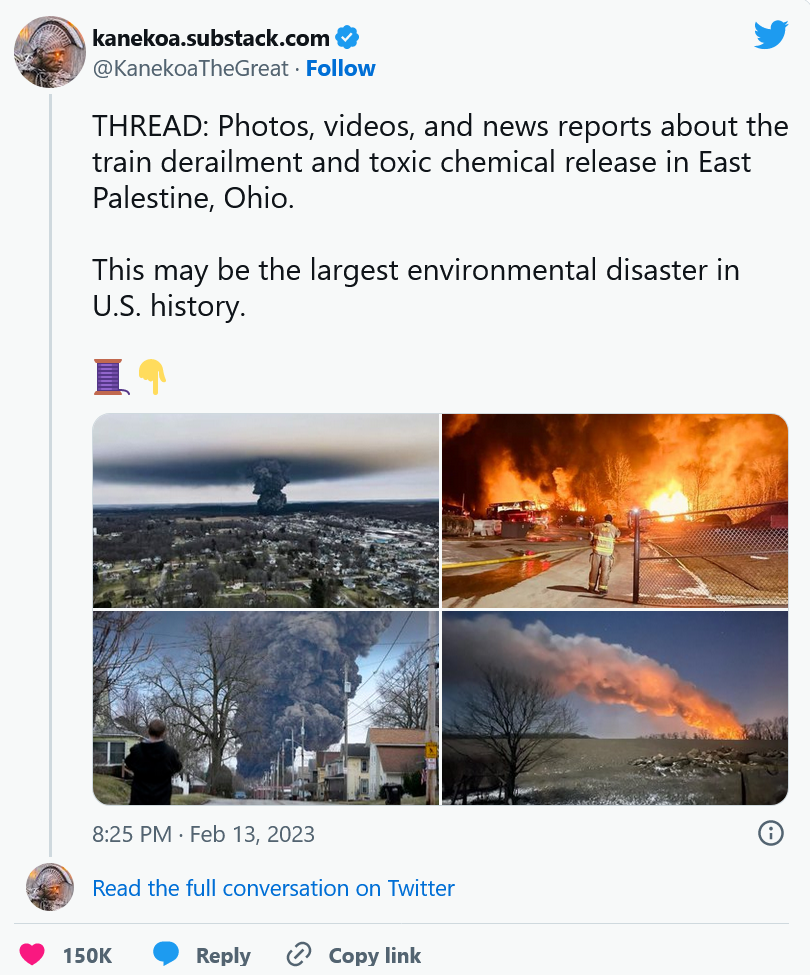
According to U.S. media reports, at about 9pm on February 3, a Norfolk Southern train derailed in the Ohio town of East Palestine, which is located about 80.5 kilometers northwest of Pittsburgh, Pennsylvania, and has about 4,700 residents. At the time, about 50 of the 150 cabins of the moving train ran off the tracks, 20 of which were carrying toxic chemicals.

The U.S. media cited a preliminary investigation that the derailment was caused by a mechanical failure of one cabin’s axle. Video footage of the train passing along the tracks showed sparks or flames underneath at least one of the train’s cabins as it passed through Salem, another city 32 kilometers from East Palestine.
The train, operated by Norfolk Southern, has been carrying chemicals and combustible materials. The US National Transportation Safety Board (NTSB) previously confirmed that the derailed cabins were loaded with hazardous materials, including 14 cars with vinyl chloride. According to the U.S. Environmental Protection Agency (EPA), exposure to high airborne concentrations of vinyl chloride can damage the central nervous system, and long-term exposure has been shown to cause liver damage, including a rare form of liver cancer. The combustion of vinyl chloride produces hydrogen chloride and phosgene, a highly asphyxiating poisonous gas that can cause pulmonary edema when inhaled at high concentrations and was used as a chemical weapon during World War I.

Norfolk Southern officials said the cabin containing the vinyl chloride did not rupture in the accident but had an explosion risk, so crews vented and burned the contents on February 6. Smoke remained over the town for hours during the two days of burning. Earlier, Ohio and Pennsylvania ordered the emergency evacuation of thousands of residents nearby. Then on February 8, the evacuation order was lifted, the federal and state governments unanimously determined that local water and air quality met safety standards, and people who had previously been asked to evacuate were allowed to return to their homes.
However, residents did not buy it. Katlyn Schwarzwaelder, who lives just less than 1 kilometer from the incident, pointed out that the locals are asking for an impartial third party to test the quality of the local water, soil, and air. They may not be able to return home for a long time.

According to the Washington Post, more than 1,000 residents have been affected, and some are suffering from depression, anxiety, and other emotions as a result. Some people have taken Norfolk Southern to court, demanding compensation and medical monitoring,etc.
On February 11, the U.S. Environmental Protection Agency (EPA) sent a letter to Norfolk Southern that included information about the pollutants released or threatened into the environment after the train derailment. The letter also outlined the EPA’s cleanup actions at the site and the possibility of requiring the railroad to bear the associated costs. The agency did not provide detailed information about when the accident site could be considered fully restored to normal.
Although the U.S. public is concerned about the serious consequences of the train derailment, U.S. Transportation Secretary Pete Buttigieg only talked about the government’s achievements in infrastructure projects when he attended an event on the 13th and did not mention the train derailment that led to the vinyl chloride leak and its subsequent effects.
The railroad stated on the 13th saying that a preliminary report on the train derailment “containing all factual information” will be released within 30 days.
Greg Regan, president of the Transportation Trades Department, AFL-CIO, a labor organization consisting of 33 unions that together represent workers in all areas of transportation, said he fears the chances of catastrophic derailments are increasing because major freight railroads have lost about a third of their workforce in the past six years. To cut costs, railroads have slimmed down their operating models, reducing headways and increasing car lengths, and a large number of crews and mechanics have been laid off as a result.
Before the operational restructuring, inspectors typically had about two minutes to check each cabin; now they have only about 30 to 45 seconds, Reagan said. Signalmen who maintain crossings and safety lights are responsible for a larger supervisory area, all of which increase the risk of safety incidents.

In addition, the arrest of NewsNation’s African-American reporter Evan Lambert-McMichael at a press conference on the 8th is also of great concern. Some media said Lambert was arrested for “reporting the facts,” and police said Lambert’s live broadcast was “too loud” that day. To ensure that other media in the audience “received the necessary information “, he was asked to stop the live broadcast, which is irrelevant to the news blackout because there were other media present.
According to the surveillance video, an altercation ensued between Ohio National Guard Adjutant General John Harris and Lambert. Harris said Lambert was “aggressive” and rushed him, and that he pushed Lambert away because he “felt physically threatened”. After repeatedly asking Lambert to leave the scene were refused, the police decided to send him away and arrested him for trespassing.
(Source: NewsStation, NPR, CBS Pittsburgh, opindia)



